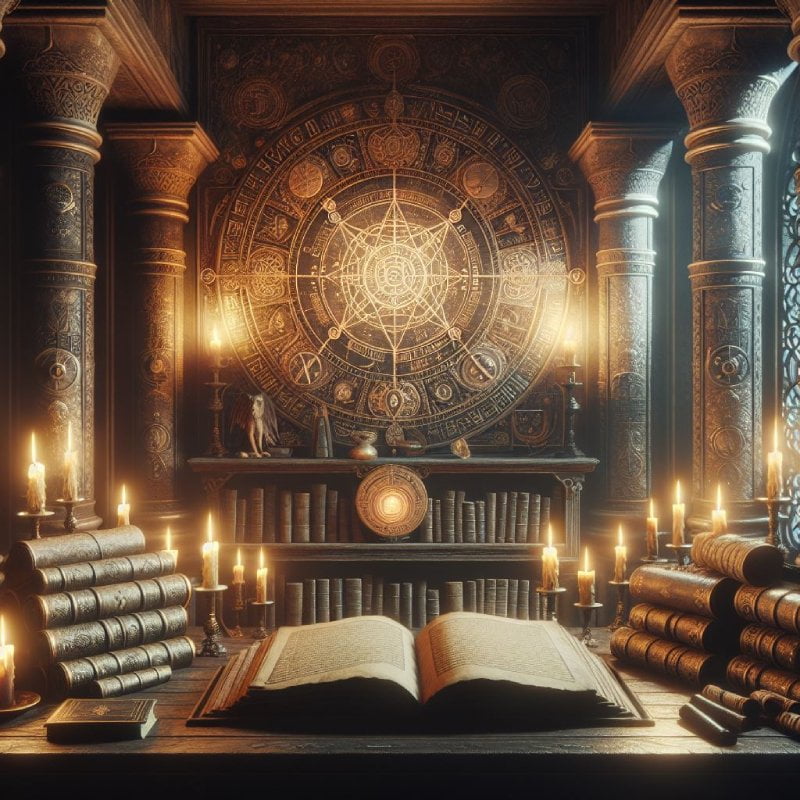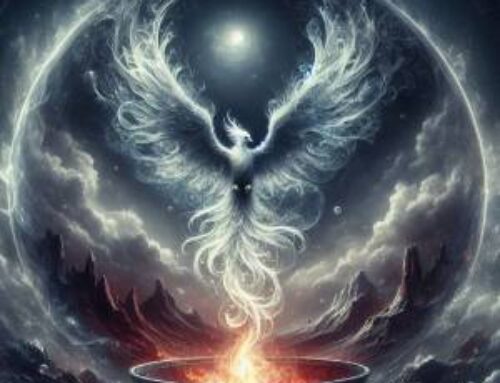Contents
Introduction to Magic Theory
A General Theory of Magic explores magic in primitive societies and its survival in our thoughts and social actions, offering sociological and religious insights still relevant today (1).
Magic theory is not merely an archaic relic of the past but a living, breathing framework that offers profound insights into the workings of the cosmos and our place within it. This fascinating discipline stretches across the annals of time, threading through ancient civilizations and influencing myriad cultures with its enigmatic principles and practices. At its core, magic theory reveals the intricate tapestries of causality and influence that bind the visible and invisible worlds together.

In this exploration, we delve deep into the historical foundations of magic theory, unearthing the philosophical stones upon which modern mystical practices are built. We examine the key principles such as correspondence, vibration, and polarity, which echo through the halls of Hermetic teachings and beyond. Furthermore, we uncover the essential roles that symbols and rituals play in the practice of magic, serving as the conduits through which practitioners manipulate cosmic energies to manifest their will.
As we embark on this journey through the mystical arts, we invite readers to open their minds to the possibilities that magic theory presents—not just as a theoretical study but as a practical guide to expanding one’s perceptual and spiritual horizons.
Historical Foundations of Magic Theory
Ancient Origins and Philosophical Roots
Magic theory transcends mere folklore, anchoring its origins in the profound depths of ancient wisdom. This venerable art form traces back to the earliest civilizations, where it was intertwined with the nascent stages of science and philosophy. In ancient Egypt, for example, magicians were also priests and scholars, deciphering the divine codes of the gods to harness the forces of nature. Similarly, in Greece, figures like Pythagoras and Plato explored magic through a philosophical lens, seeing it as a branch of knowledge that reveals the harmonics of the universe.https://www.hermetic-academy.com/ancient-egypt-occult/
Evolution Through Ages
As centuries unfolded, magic theory evolved, absorbing and adapting insights from various cultures. The Renaissance period marked a significant resurgence in the study of magic, blending it with the rediscovery of Hermetic and Neoplatonic philosophies. During this era, magic was not considered occult but a sophisticated system of thought that provided insights into the celestial and terrestrial realms. Scholars like Marsilio Ficino and Heinrich Cornelius Agrippa advanced the concept that the universe is a living organism, interconnected by sympathies and antipathies, a core principle in the practice of magic.
The Hermetic Influence
Central to the development of magic theory were the Hermetic teachings, which posited that humans can affect change on the physical plane through the manipulation of universal energies—a principle encapsulated in the famed axiom “As above, so below.”(2)
This perspective painted magic as a divine science, with rituals and symbols acting as the tools for initiating changes that echo the order of the cosmos.
Key Principles of Magic
Law of Correspondence: Cosmic Symmetry and Magical Practice
Central to the mystique of magic theory, the Law of Correspondence asserts that “As above, so below; as below, so above.” This profound adage encapsulates the essence of magic as a mirror between the cosmos and the individual soul. By understanding and manipulating this symmetrical relationship, practitioners navigate the mystical landscape, using celestial alignments to influence earthly events. This principle extends beyond theoretical abstraction, forming the backbone of astrological magic where the positions of stars and planets are believed to directly impact personal and spiritual endeavors.
Law of Vibration: Resonance and the Art of Magical Influence
Magic asserts that every element of the universe vibrates at a distinct frequency, and these vibrations encompass more than physical motion—they resonate through emotions, thoughts, and spiritual energies. The Law of Vibration empowers magicians to align their personal energy with the universe’s rhythmic pulse to manifest intentions. Through chants and sacred sounds, a practitioner can tune into these frequencies, crafting spells that resonate with specific energies to attract love, prosperity, or protection. This law underscores the magical maxim of ‘to know,’ as understanding the vibrational nature of targets is key to effective magical work.
Law of Polarity: Harnessing Opposites for Magical Equilibrium
The Law of Polarity reveals that all things exist as inseparable and contradictory opposites. Magic theory utilizes this principle to mediate and balance these forces within rituals. For example, a healing spell may invoke the polarity of health and illness, actively transforming malaise into wellness through a symbolic merging of opposites. This law not only guides the ‘to dare’ aspect of magical practice—daring to transform reality through the balancing of forces—but also integrates the ‘to will,’ focusing the magician’s intent on achieving a harmonious state.
The Four Maxims of Magical Practice
Integral to the practitioner’s journey are the four maxims of magic: to know, to dare, to will, and to keep silent. Each maxim relates to a core aspect of magical practice:
- To Know: Understanding the laws and symbols used in magical operations.
- To Dare: The courage to engage with the mystical forces and to face the unknown.
- To Will: The focused intent and energy directed towards achieving specific outcomes.
- To Keep Silent: The discretion that preserves the potency of the spell and shields the practitioner from external influences.
These maxims are not just rules but serve as pillars that support the ethical and effective practice of magic. They remind the magician that true power comes from a deep understanding of the natural world’s laws, the courage to implement them, the will to succeed, and the wisdom to withhold.
The Role of Symbols and Rituals in Magic
Symbols: The Vessels of Esoteric Energy
Symbols in magic are not merely decorative; they are potent vessels that embody esoteric energies and principles (3). Each symbol, whether it is a geometric sigil, a written glyph, or a complex mandala, serves as a focal point for magical intentions. They encapsulate and channel the metaphysical forces they represent, making them essential tools for any practitioner. For example, the Ankh symbol in Egyptian magic represents eternal life and is used in rituals to promote healing and longevity.
Rituals: The Choreography of Magical Intent
Rituals are the choreographed movements and words that magicians use to align personal energy with universal forces. They involve a series of deliberate actions—casting circles, invoking deities, and channeling energies—designed to manifest specific outcomes. Through rituals, practitioners bring the abstract into the tangible, transforming thought and desire into reality. For instance, a simple candle magic ritual can draw specific energies by color correspondence: red for passion, blue for healing, or green for prosperity.
Group rituals serve as psychological mechanisms for identifying group members, ensuring commitment, facilitating cooperation, and maintaining cohesion in group living (4).
Integration of Symbols and Rituals
Combining symbols and rituals in magic theory is akin to writing and performing a symphony where every note and instrument plays a crucial role. Symbols are like the notes—each carries a specific vibrational quality and meaning. Rituals are the performance, arranging these notes in a harmonious sequence that resonates with the energies of the universe. This integration is crucial for effective magical work, as it allows the practitioner to communicate deeply with the world’s unseen layers.
Practical Applications and Ethical Considerations
Magic, when performed with a deep understanding of its symbols and rituals, can be a powerful tool for personal transformation and for influencing one’s environment. However, it demands not only knowledge and skill but also ethical consideration and responsibility. Practitioners must consider the broader impacts of their work, respecting the free will of others and the natural laws of the universe.
Conclusion
As we conclude our exploration of “Magic Theory: Exploring the Timeless Principles Behind the Mystical Arts,” it becomes evident that magic is more than mere folklore or ancient rituals; it is a profound pathway to understanding the deeper mechanisms of the cosmos. The principles of Correspondence, Vibration, and Polarity provide a framework through which we can perceive and interact with the world at a more intimate level. Symbols and rituals, the tools of the magician, are not just ceremonial but are practical applications of these age-old theories, crafted to influence and manifest real-world changes.
Magic is not just a subject to be studied but a craft to be lived. By embracing its principles and applying its practices, you not only transform your own life but also contribute to the broader tapestry of human experience and understanding.
Seek the Path of Light
To further your understanding and mastery of magic theory, consider engaging with resources that delve deeper into the esoteric traditions. The Hermetic Academy offers courses, texts, and an initiatory community of like-minded individuals dedicated to the practice of Hermeticism and the magical arts.
FAQ – Magic Theory
1. What is Magic Theory?
A: Magic theory is a framework that explores the principles and laws governing the mystical arts. It encompasses the study of how universal forces and energies can be understood and manipulated through specific practices, including the use of symbols and rituals. This theory is rooted in ancient wisdom and spans across various cultures and epochs, providing insights into both the material and spiritual dimensions.
2. How does the Law of Correspondence apply to Magic Theory?
A: The Law of Correspondence, a fundamental principle in magic theory, posits that the macrocosm and microcosm reflect each other. In practical terms, this means that actions performed on a small scale can influence broader universal energies. This principle is crucial for understanding how magical rituals and symbols can be used to affect change in the practitioner’s environment and life.
3. Can you explain the significance of symbols in Magic Theory?
A: In magic theory, symbols are not just representational; they are considered potent tools that hold the essence of the energies they represent. Each symbol, whether it’s a rune, sigil, or glyph, is a concentrated force that magicians harness to direct specific energies during rituals. Symbols act as focal points, helping to align the practitioner’s intention with universal forces.
4. What role do rituals play in Magic Theory?
A: Rituals in magic theory are structured actions that use symbols, words, and objects to manifest a desired outcome. They are the practical application of magical principles, designed to channel and transform energies in accordance with the magician’s will. Through rituals, practitioners actively engage with the laws of the universe, such as Vibration and Polarity, to bring about change in the physical world.
5. How can someone begin to practice Magic Theory responsibly?
A: New practitioners should study under experienced Mystery Schools, such as the Hermetic Academy.
References
(1) Mair, L., Mauss, M., & Brain, R. (1973). A General Theory of Magic. British Journal of Sociology, 24, 132. https://doi.org/10.2307/588824.
(2) Rubenstein, E. (2024) The Hermetic Experience: From Mystery to Self-Knowledge. Hermetic World, Paphos.
(3) Rubenstein, E. (2023). Magic: The Legacy of the Rosicrucians. Hermetic World, Paphos.
(4) Watson-Jones, R., & Legare, C. (2016). The Social Functions of Group Rituals. Current Directions in Psychological Science, 25, 42 – 46. https://doi.org/10.1177/0963721415618486.





